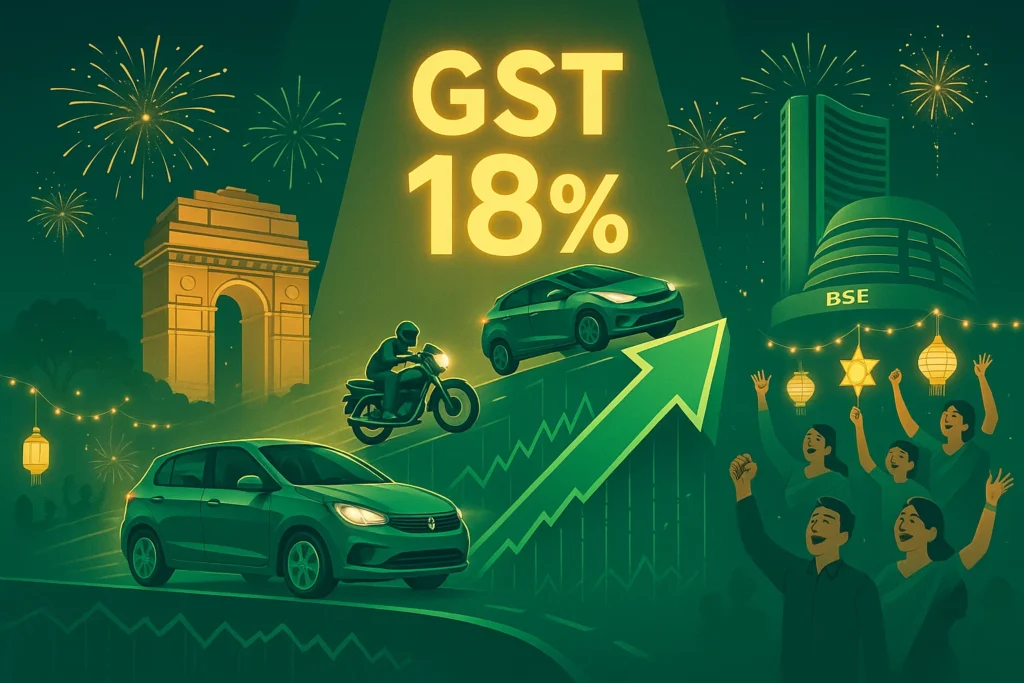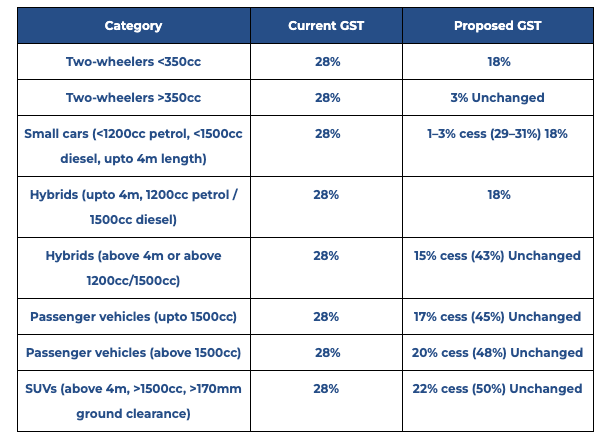Introduction – Why GST Cut on Auto Stocks Matters Now
The Indian government is reportedly considering a GST cut on auto stocks, specifically cars and two-wheelers, reducing the Goods and Services Tax from the current 28% to 18% for certain categories. This development comes as a Diwali gift to consumers and investors alike.
The market has already cheered the news. On reports of a possible GST revision, the Nifty Auto Index jumped 4.6%, reflecting investor optimism about a demand revival in the automobile sector. If approved, this tax cut will not only make vehicles more affordable but also lift the sales volumes for manufacturers, ancillary companies, and auto financiers.
For traders and long-term investors, the GST cut on auto stocks could mark the beginning of a structural uptrend in the sector. Let’s break down the details and identify potential winners.
The Proposed GST Cut on Auto Stocks Explained
Currently, automobiles in India fall under the highest tax slab of 28%, with additional cess on SUVs and luxury cars. The government is reportedly considering the following revisions:
- Two-wheelers (<350cc): GST may drop from 28% → 18%
- Small Cars (Petrol <1200cc, Diesel <1500cc, under 4m length): Effective tax ~29–31% → 18%
- Hybrids (upto 4m, small engines): 28% → 18%
- Luxury Cars & SUVs: No change, continue at 40–50% (with cess)
The aim is clear — boost affordability for middle-class buyers, revive demand in rural and semi-urban markets, and simplify the tax system.
From an investment perspective, this GST cut on auto stocks would directly benefit manufacturers in the two-wheeler and entry-level car segment, while also creating ripple effects for ancillary industries like tyres, batteries, auto components, and even financial lenders.
Direct Beneficiaries of GST Cut on Auto Stocks
Two-Wheeler Companies
The two-wheeler segment is expected to be the biggest gainer if the GST cut goes through. With motorcycles and scooters becoming cheaper by nearly 10%, rural and semi-urban demand is likely to surge.
- Hero MotoCorp – India’s largest two-wheeler maker, with a strong presence in the commuter bike category, stands to benefit the most.
- Bajaj Auto – A leader in motorcycles with strong exports, a GST cut could revive its domestic sales momentum.
- TVS Motor – With scooters and bikes in the entry-level and mid-range segments, TVS would see both volume and market share growth.
For investors, these companies could see double-digit sales growth in FY26 if the GST cut on auto stocks becomes a reality.
Small Car Makers
The small car and hatchback category, dominated by Maruti Suzuki and Tata Motors, is another clear beneficiary. Affordable cars like Alto, Swift, Punch, and Tiago could see a surge in demand once prices come down.
- Maruti Suzuki – As India’s largest carmaker with strong entry-level offerings, it could see a major volume boost.
- Tata Motors – Already on a growth path with popular models, Tata would benefit from increased price competitiveness.
- Mahindra & Mahindra – Though largely known for SUVs, its smaller vehicle portfolio would also gain indirectly.
The GST cut on auto stocks could push retail buyers, especially first-time car owners, back into showrooms after years of sluggish demand in the small car category.
Hybrid Vehicles – The Future Winners
Hybrid vehicles are also expected to benefit from the reduced tax rate. Currently taxed at 28%, a cut to 18% would make hybrids more attractive, especially for cost-conscious urban buyers.
- Maruti Suzuki (Grand Vitara, Hyryder hybrids) would see improved adoption.
- Toyota Kirloskar (via suppliers) could push its strong hybrid portfolio in India.
- Tata Motors – Already leading in EVs, Tata may also expand hybrid offerings with the cost advantage.
With the government’s focus on green mobility, the GST cut on auto stocks could accelerate the transition towards hybrid and fuel-efficient cars.
Indirect Beneficiaries of GST Cut on Auto Stocks
The impact of a GST reduction won’t just stop at OEMs (original equipment manufacturers). Several ancillary industries would also see tailwinds:
- Auto Ancillaries: Companies like Motherson Sumi, Bosch, Bharat Forge stand to gain as vehicle volumes rise.
- Tyres: Higher demand for two-wheelers and cars means stronger orders for MRF, Apollo Tyres, JK Tyre, Balkrishna Industries.
- Batteries: With higher vehicle sales, Exide Industries and Amara Raja will see stronger demand for both OEM and aftermarket batteries.
- Paints: Companies like Asian Paints and Kansai Nerolac supply coatings to auto OEMs, and rising production would boost their revenue.
- Banks & NBFCs: More car and bike purchases mean higher auto loan demand, benefiting HDFC Bank, SBI, ICICI Bank, Bajaj Finance and other lenders.
Thus, the GST cut on auto stocks has the potential to create a ripple effect across multiple sectors, making it one of the most impactful reforms for investors.
Market Reaction So Far
The news of a possible GST cut on auto stocks triggered an immediate positive response from the markets. The Nifty Auto Index surged 4.6% on the report, reflecting strong optimism among investors. Key auto stocks such as Maruti Suzuki, Hero MotoCorp, Bajaj Auto, TVS Motor, and Tata Motors saw sharp intraday gains, while ancillary companies like Bosch, Motherson Sumi, and Bharat Forge also benefitted from the sentiment.
Analysts believe that if implemented, the GST cut will structurally re-rate valuations in the auto sector. For the first time in years, entry-level vehicles may see significant demand expansion, creating a multi-year growth cycle for the industry.
Festive Season Impact & Diwali Sales Boost
The timing of the proposed GST cut is crucial. With the festive season and Diwali sales approaching, automakers were already gearing up for higher volumes. A reduction from 28% to 18% GST on small cars, two-wheelers, and hybrids could provide a massive festive boost.
- Two-Wheeler Demand Surge: Companies like Hero MotoCorp, Bajaj Auto, and TVS Motor are expected to be the biggest beneficiaries as affordability improves for rural and urban buyers.
- Small Car Momentum: Entry-level models from Maruti Suzuki, Hyundai, and Tata Motors could see strong booking momentum as middle-class households make buying decisions around festive offers.
- Hybrid Vehicles: Toyota and Maruti Suzuki, which already have hybrid portfolios, may gain significant traction as lower GST makes hybrids more price competitive compared to conventional ICE vehicles.
Brokerages expect record festive season sales if the GST cut gets implemented before Diwali, potentially creating a strong earnings momentum for Q3 FY26.
Long-Term Sector Outlook
The GST cut on auto stocks has the potential to reshape India’s automobile industry in the long run.
- Wider Market Expansion – With affordability improving, more first-time buyers are expected to enter the market, driving long-term consumption.
- Shift to Hybrids & EVs – Lower GST on hybrids could bridge the price gap between ICE vehicles and EVs, accelerating India’s transition to cleaner mobility.
- Ancillary Growth – Auto component manufacturers, tyre companies, battery makers, and financing firms (like Bajaj Finance & Shriram Finance) will also benefit indirectly from rising volumes.
- Employment & GDP Impact – The auto industry contributes nearly 7% to India’s GDP. Higher volumes could generate employment across dealerships, manufacturing, and supply chains.
Thus, the GST cut could serve as a multi-year growth trigger, much like the tax reforms of the early 2000s that spurred consumption.
Risks to Watch
Despite the bullish sentiment, investors must also be mindful of risks:
- Policy Delays: The GST Council is still deliberating, and any delay in approval could cool down market optimism.
- Revenue Concerns: States may resist the cut due to fears of reduced GST collections, leading to watered-down reforms.
- Rising Input Costs: Even with a tax cut, high commodity costs (steel, aluminium, battery materials) could pressure margins.
- EV Policy Uncertainty: Aggressive EV adoption and future subsidies may overshadow hybrids, making stock performance uneven across sub-segments.
Being aware of these risks will help investors take a balanced approach while riding the momentum.
Final Conclusion & Investor Takeaway
The proposed GST cut on auto stocks is more than just a tax reform — it is a structural shift that could unlock demand in India’s auto industry. With affordability improving for two-wheelers, small cars, and hybrids, the sector is set for a demand revival ahead of Diwali and beyond.
- Top Beneficiaries: Maruti Suzuki, Hero MotoCorp, Bajaj Auto, TVS Motor, and Tata Motors in the direct space.
- Indirect Beneficiaries: Auto component firms like Bosch, Motherson Sumi, and tyre companies like MRF, Apollo Tyres, CEAT. Financing firms such as Bajaj Finance and Shriram Finance also stand to gain.
- Near-Term Outlook: Strong festive season demand and Q3 FY26 earnings upgrades.
- Long-Term Outlook: Structural demand growth, higher employment, and better alignment with cleaner mobility.
For investors, this may be the biggest auto sector trigger since GST rollout in 2017. Allocating to quality auto and ancillary stocks now could provide strong medium- to long-term gains, though tracking policy developments closely is essential.
FAQs on GST Cut on Auto Stocks
1. What is the latest update on GST cut on auto stocks?
The government is considering reducing GST on cars and two-wheelers from 28% to 18%, which could directly benefit auto companies and their stock prices.
2. Why is the GST cut important for the auto sector?
A GST cut on auto stocks makes vehicles more affordable, boosting sales volumes, especially for two-wheelers and entry-level cars, leading to higher earnings for auto companies.
3. Which auto stocks will benefit the most from the GST cut?
Stocks like Maruti Suzuki, Tata Motors, Hero MotoCorp, Bajaj Auto, and TVS Motor are expected to see strong demand recovery, making them top beneficiaries.
4. How will GST cut impact two-wheeler sales?
Two-wheelers form the bulk of India’s auto sales. With lower GST, motorcycles and scooters will become more affordable, driving rural and urban demand.
5. Will hybrid and electric vehicles gain from GST cut on auto stocks?
Yes. Hybrids may benefit more as the cut will reduce the price gap with ICE vehicles, while EVs already enjoy lower GST but could see indirect demand push.
6. How has the stock market reacted to the GST cut news?
The Nifty Auto Index jumped 4.6%, and many auto stocks surged after reports of the potential GST cut, reflecting investor optimism.
7. Will auto ancillary stocks also benefit from GST cut?
Yes. Companies like Motherson Sumi, Bosch, Apollo Tyres, and battery makers will gain as higher vehicle sales increase demand for components.
8. Is this GST cut confirmed?
Not yet. The GST Council is still discussing it, and final approval will depend on consensus between the Centre and states.
9. What are the risks for investors betting on GST cut on auto stocks?
Delays in policy approval, resistance from states over revenue loss, and high raw material costs are key risks to watch.
10. Should investors buy auto stocks now or wait?
Investors with a medium-to-long-term horizon can consider buying quality auto stocks on dips, but should track government announcements closely before making big allocations.
Related Articles:
How to Read Quarterly Results: A Beginner’s Guide to Earning Reports
Golden Crossover vs Death Crossover: How to Use These Powerful Chart Signals
Protect Your Demat Account from Cyber Threats: A Complete Guide
More Articles
How to Transfer Shares from Groww to Zerodha – Full Guide (2025)
Best Screener Queries for Stock Selection: Find Hidden Gems Before Others Do
How a Tea Seller Used the Power of Compound Interest to Build ₹45 Lakh





